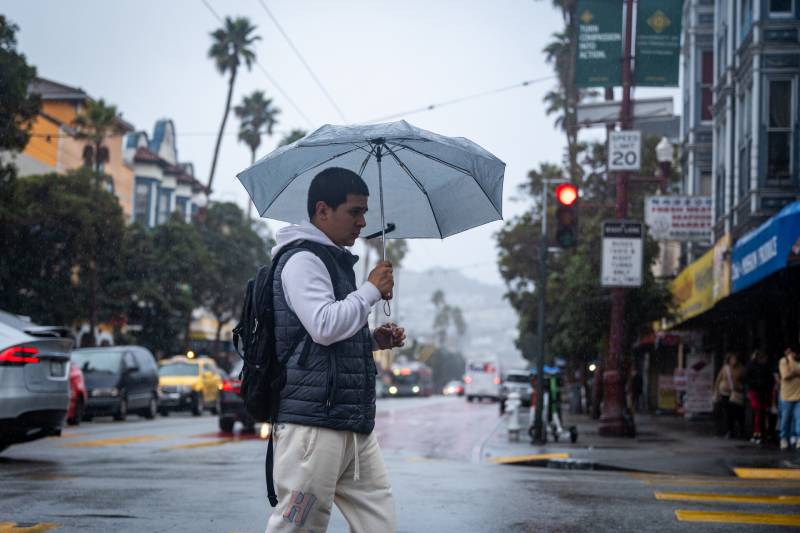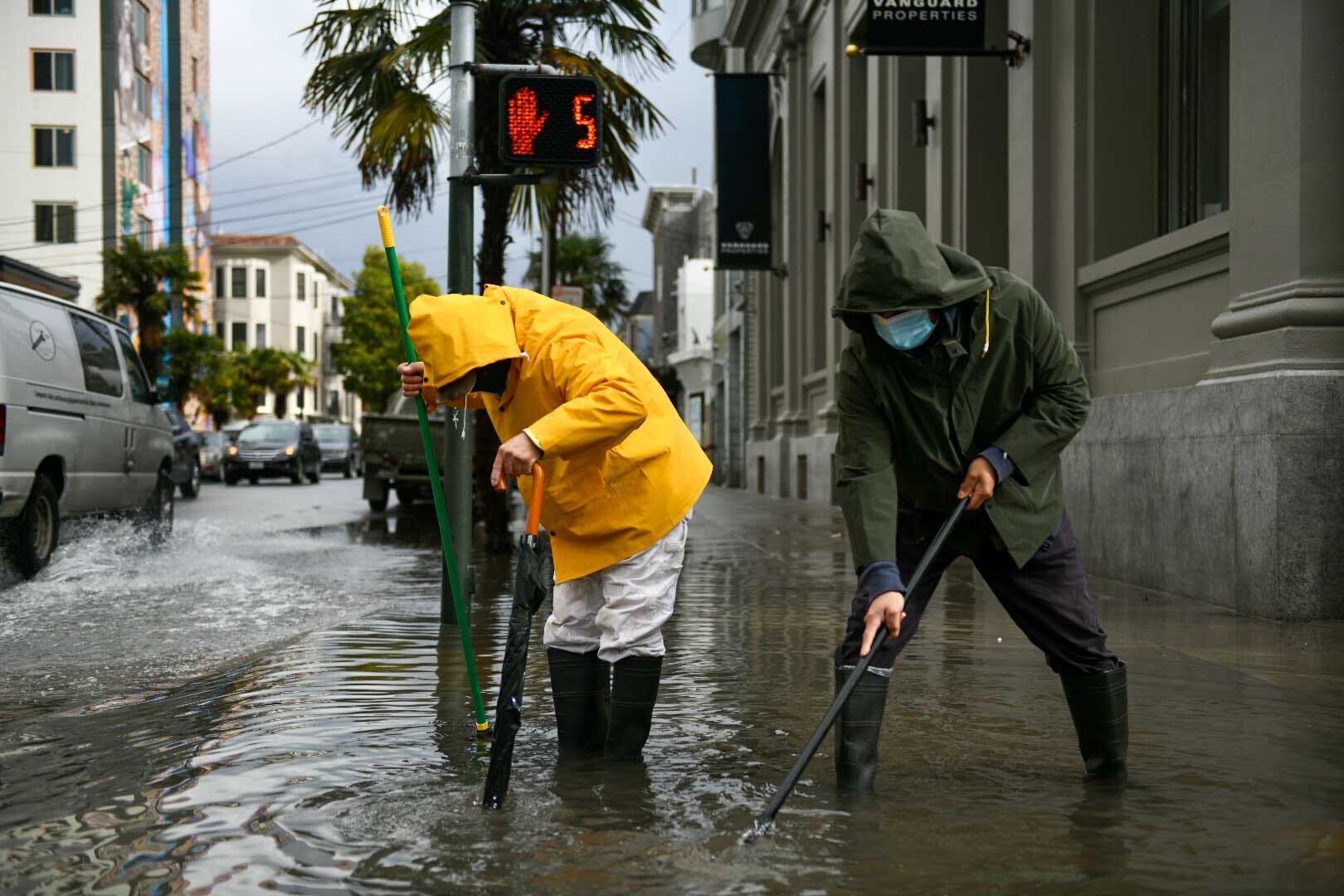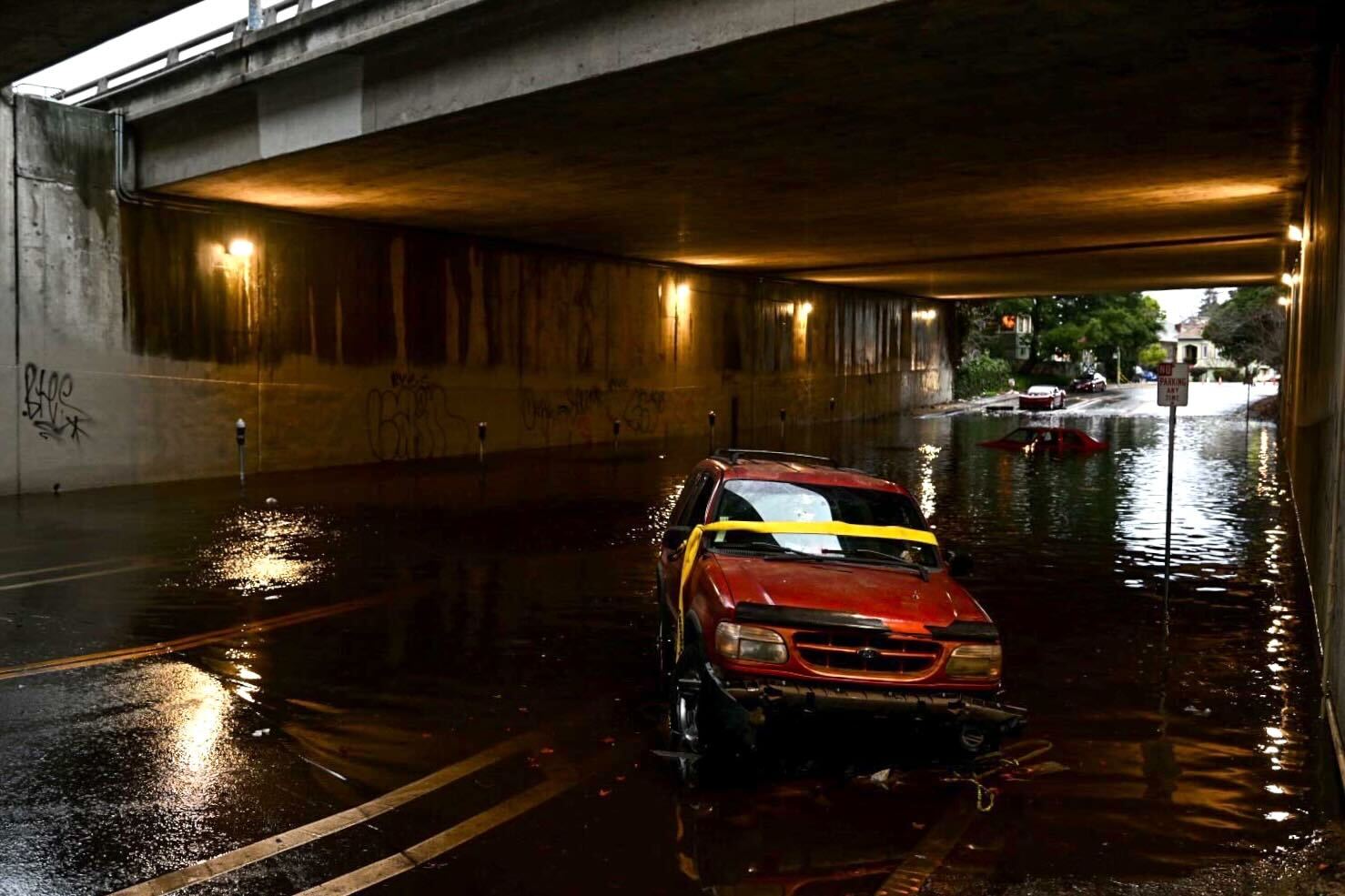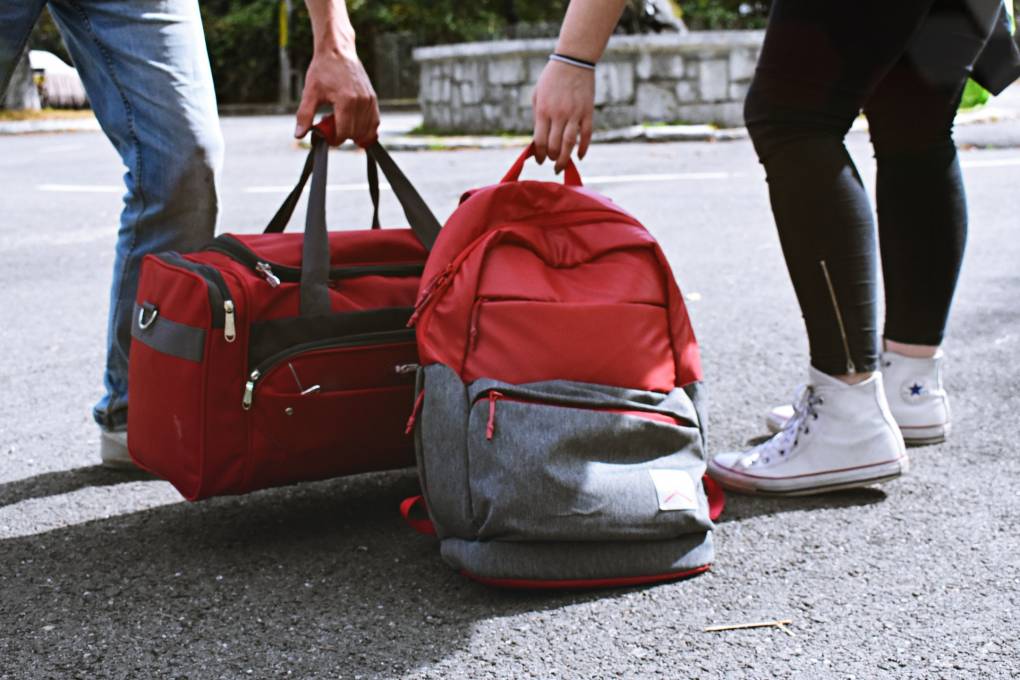The rain and wind are back, Bay Area. An atmospheric river is bringing heavy rains to the region, with Sonoma County getting more than two inches of rain on Wednesday morning alone.
Bay Area Weather: As New Storms Bring More Rain, How You Can Prep for Flooding, Winds and Power Outages

A flood warning is in place for Napa, Sonoma and Marin counties through Friday morning. Meteorologists say that North Bay residents can expect creeks to fill up, while there is some risk that highways and streets could flood — specifically in Sonoma County communities surrounding Highway 101. Up to 10 inches could fall in areas north of Healdsburg.
San Francisco and parts of the East Bay will also see rain and cloudy skies throughout the week, but not at the same levels as the North Bay.
While this atmospheric river system is not expected to have the intensity as those that hit the region at the start of the year, officials are still recommending residents to take action in the event of the worst — especially for folks who live in areas prone to flooding. Jump to how to prepare your home for a storm.
Even if you don’t live in a low-lying area, there’s other things you should take into account, like downed power lines that could be active and avoid driving into flooded areas. “Honestly, it would just be a good weekend to stay home and just stay out of the way,” said National Weather Service meteorologist Nicole Sarment.
What is an atmospheric river?
An atmospheric river is a kind of weather system that brings trillions of gallons of water vapor from the Pacific Ocean to California.
In 2023, winter storms brought flooding as well as extreme winds, and claimed the lives of at least five people around the Bay Area. Before that, another winter storm caused the Pajaro River on the border of Monterey and Santa Cruz counties to breach a levee on March 10, flooding the Pajaro River Valley, prompting rescues and placing more than 8,500 people under evacuation orders and warnings.
During these kinds of weather events, knowing how to prepare for the worst — and how to cope if you’re directly affected — is crucial. Bay Area officials are routinely urging residents to prepare before the next big rainstorm arrives, providing free sandbags, sharing information on flood insurance and more.
Keep reading to learn when the biggest weather impacts will hit the Bay Area, how to safeguard your home from flooding and how to cope with power outages caused by the storm.
Jump to:
- How should I prepare my home for a storm?
- Where can I get free sandbags?
- How can I be ready for potential power outages?
- What are best practices for driving in heavy rain and wind?
- How can I receive updates about my area?
How should I start preparing?
First up, understand just how much you — and your home — could be affected by another storm of this magnitude.
Previous storms in the Bay Area have knocked down trees, flooded roads and cut power to tens of thousands of homes and businesses, and contributed to several deaths. Winds have also previously forced the cancellation of flights at local airports including San Francisco International Airport.
Flooding could mean you have to evacuate your home, or live without crucial services for an extended period. Besides flashlights, experts recommend having an emergency supply kit ready in both your home and car — should you need to evacuate — that includes nonperishable foods, necessary medications, cleaning supplies and water for several days, in case services are cut off in your area. You can also include a copy of your ID, charging cables for your cellphone and a portable cellphone battery pack.
Previous storms in the Bay Area have resulted in power outages that affected over 100,000 PG&E customers. Read more about preparing your home for a potential power outage in this next storm.

If your home experienced flooding during previous storms this year — or in storms from years past — officials recommend having sandbags, plastic sheeting and other flood control materials ready. Counties, public utilities and even community organizations across the Bay Area are distributing free sandbags. Keep in mind that some distribution sites, like those in San Francisco and San José, may ask you to show ID to prove you are a resident. Learn more about where to find sandbags.
Following the atmospheric river storm that hit Northern California on New Year’s Eve 2022, officials around the Bay Area have doubled down on efforts to keep waterways and storm drains clear to reduce the risk of flooding in residential areas. Both Oakland and San Francisco have programs where residents can “adopt” a storm drain in their community and help remove leaves and other debris.
FEMA also has created a tool that tracks which parts of a city are under flood risk — and to what extent. You can input your address in the FEMA Flood Map Service Center. Once the map tool locates your address, you can select the “Dynamic Map” option to see a more detailed map that may have certain neighborhoods or blocks color coded to represent flood risk.
If you are a homeowner, keep in mind that most home insurance plans do not cover damage caused by flooding. However, you can buy an additional policy with the National Flood Insurance Program through your existing insurance provider. It’s important to mention that if you decide to buy a plan now, there is a 30-day wait period for the benefits to begin, so the policy would not cover damages potentially caused by this week’s storms.
I need sandbags. Where can I get them?
In San Francisco, officials in the past have stressed that only residents who have previously experienced flooding in their homes should seek out the free sandbags provided by city agencies. Additionally, San Mateo County has added on its emergency preparation website that sandbags brought out during a previous storm can be reused.
Santa Clara Valley Water has created a helpful video tutorial on how best to place sandbags around a home.
If your home has flooded in the past and you’re looking to pick up free sandbags, several options are available. Be aware that some sites may offer bags and sand separately or exclusively, and that you may need to bring your own shovel to some locations. You may also be required to prove county residency with an ID. Be sure to research the site you’re visiting before leaving.
Alameda County: In Alameda County, residents can pick up sandbags supplied by the County Public Works Agency from four sites.
City of Berkeley: Berkeley residents and businesses can get up to five sandbags with an ID or business card, from the City of Berkeley Corporation Yard (located on 1326 Allston Way, open 8 a.m.–4 p.m. Monday–Friday).
Contra Costa County: Each city in Contra Costa County has its own sandbag pickup locations. You can find the contact information for your city’s sandbag distribution site here (PDF). Additionally, if you live in an unincorporated part of the county, six additional locations are available.
Marin County: Marin County has a list of both government-provided locations and commercial/retail options for sandbags.
Napa County: In addition to the county-run sandbag locations below, Napa County also recommends residents of American Canyon, Napa, St. Helena, Calistoga and Yountville contact their city directly for sandbag locations and availability (PDF).
San Francisco: San Francisco is offering up to 10 sandbags per resident at their Operations Yard (located on the corner of Marin and Kansas, near Cesar Chavez). Although the site usually closes at 2 p.m., it will be open till 5 p.m. on Thursday, according to a tweet from the city’s public works agency.
San Mateo County: San Mateo County offers a limit of 15 premade sandbags per resident, and says the county will also “provide materials for individuals to fill as many bags as they need on their own.”
Santa Clara County: Santa Clara County residents can pick up free sandbags from several locations managed by Santa Clara Valley Water.
Solano County: All locations are self-serve and require your own shovel.
Sonoma County: Sandbags are available at over 10 locations around the county.
How can I be ready for potential power outages?
Flooding, downed trees and downed power lines: All of these can create the very real possibility of power outages during a storm like this.
Remember: It can sometimes take days for PG&E to do safety checks and turn your power back on, particularly if an outage affects a large enough number of people. If you have medical needs that rely on power, consider planning which family members or friends you can stay with during a lengthy power outage. You might also talk to your doctor in advance about how to prepare with medications or mobility needs.
Things to have close at hand before a potential power outage:
- Battery-powered flashlights, ideally one for every household member.
- A supply of fresh batteries.
- Portable chargers or battery packs to keep your mobile phone charged.
- LED candles, instead of wax candles, are recommended by PG&E.
- A battery-powered radio to hear updates on storm conditions and outages.
- Nonperishable food (think canned goods) and water: The state recommends having enough food and water for every member of your household for three days.
- A thermometer to make sure your food is safe to eat (more on that below).
Make sure you know exactly where these crucial items are, so you’re not scrambling to find them in the dark.
Other things to do ahead of an outage:
- Fully charge your cellphone and any portable chargers.
- Get cash, as ATMs may not work during a power outage.
- Top your vehicle up with a full tank of gas (similarly, gas stations may not be operational during an outage).
- Fill up plastic containers with water and store them in your freezer, which you can use later as ice substitutes to keep food fresh.
Additionally, make sure you and your household all know:
- How to manually open any door in your home or building that requires electricity (think garage doors, apartment complex doors that require key cards).
- How you’ll communicate in an emergency situation, and not depend on a phone that needs electricity.
- How you’ll operate a generator, if you have one — check ahead of time that the one you have works, and make sure you know how to use it safely and eliminate the risk of carbon-monoxide poisoning.
As always, you should also consider checking on neighbors, especially those who may need assistance.
Mouse over or click points on the map below to see all of PG&E’s current power outages, planned or otherwise, along with the number of customers impacted, the cause (if listed), and estimated time of restoration. To see a rough approximation of power outage areas, zoom in on each location.
All data comes from PG&E, via the California Governor’s Office of Emergency Services (Cal OES), and is updated every 15 minutes. Any planned safety outages, known as Public Safety Power Outages (PSPS), will be specifically labeled on the map when they occur.
What should I do if a power outage hits my home?
Turn off almost all your appliances
If your power goes out, be sure to unplug or turn off any appliances and equipment to prevent damage from surges when the power is restored.
PG&E recommends keeping one lamp turned to the on position, to alert you when power has returned. You can then turn each appliance back on one by one.
Stay far away from any downed power lines, and report them
If you’re near a downed power line, PG&E advises that you assume it’s energized and dangerous and stay far away from it. You should:
- Make sure that others in your household, especially children, also stay far back from any downed lines.
- Call 911 to report the downed power line, and make sure you give the location clearly.
- Then call PG&E to report the downed line, at (800) 743-5000.
Keep your food safe and edible during an outage
Once your power is out, be especially purposeful about when you open your freezer or your refrigerator.
A refrigerator that loses power can keep food cold for about four hours, and a freezer for about 48 hours, if kept closed. Plan to rely on coolers with ice or any water-filled plastic containers you’ve frozen ahead of time.
The state recommends that during an outage, you monitor food temperatures with a thermometer — and throw out any food that has a temperature of 40 degrees or higher.
If you’re opting to use a camp stove or a grill in the absence of your oven or microwave, you should only use these appliances outdoors.
If you’re without power for more than 48 hours, you may qualify for compensation from PG&E. Read more about the PG&E Safety Net program, which offers these payments due to “severe events, like storms.”
A tree fell on my car. Who do I call?
We have a guide for that. Read our full advice on what to do if windy storms bring a tree down onto your car (or your house.)
How can I drive safely in rain and strong winds?
During these storms, officials urge residents to limit unnecessary travel and stay home if at all possible during weather events like these, citing the potential dangers presented by downed trees and power lines in addition to flooding.
If you must drive, use your headlights, turn off cruise control, maintain a firm grip on the steering wheel and drive more slowly and cautiously than usual. Leave twice as much space between your vehicle and the one in front of it; wet roads might mean it takes longer to stop. Be alert for debris on the road. If your car begins to hydroplane, do not slam on the brakes. Remain calm, ease off the gas, steer in the direction you want to go and very lightly pump the brakes until you regain traction.

If flooding occurs, err on the side of caution. Don’t assume you know the depth of a pool of water or the conditions of the road underneath it, especially at night.
Always turn around rather than driving through a flooded area — as few as 6 inches of water is enough to disable or stall a small car, while 12 inches can sweep away a vehicle. If floodwaters begin to rise around your car, abandon the car and move to higher ground on foot. According to the California Department of Water Resources, more people become trapped and die in their vehicles than anywhere else during a flood.
How can I receive updates about my area?
If you haven’t done so already, sign up to receive emergency weather alerts from your county. County officials use these notifications to inform residents of weather alerts, street and road closures, and evacuation orders. Find your county below:
- Alameda County emergency alerts
- City of Berkeley emergency alerts
- Contra Costa County emergency alerts
- Marin County emergency alerts
- Napa County emergency alerts
- City and County of San Francisco emergency alerts
- San Mateo County emergency alerts
- Santa Clara County emergency alerts
- Solano County emergency alerts
- Sonoma County emergency alerts
In San Francisco, officials have asked the public to call 311 to report flooding inside homes, instead of 911. “We still have to run all our critical 911 calls whether it’s a cardiac arrest, a car accident or a fire. If you add all these flooding issues … it can really overtax the system,” Fire Chief Jeanine Nicholson said in January 2023, days before the start of that year’s winter storm system.
“So if you have a little bit of flooding in your home, call 311,” she said. “If someone is having a heart attack or if someone is being swept by water, call 911.”
An earlier version of this story was published on Feb 2., 2024. KQED’s Ezra David Romero, Katie DeBenedetti, Danielle Venton, Kevin Stark, Daisy Nguyen and Erin Baldassari contributed to this story.
